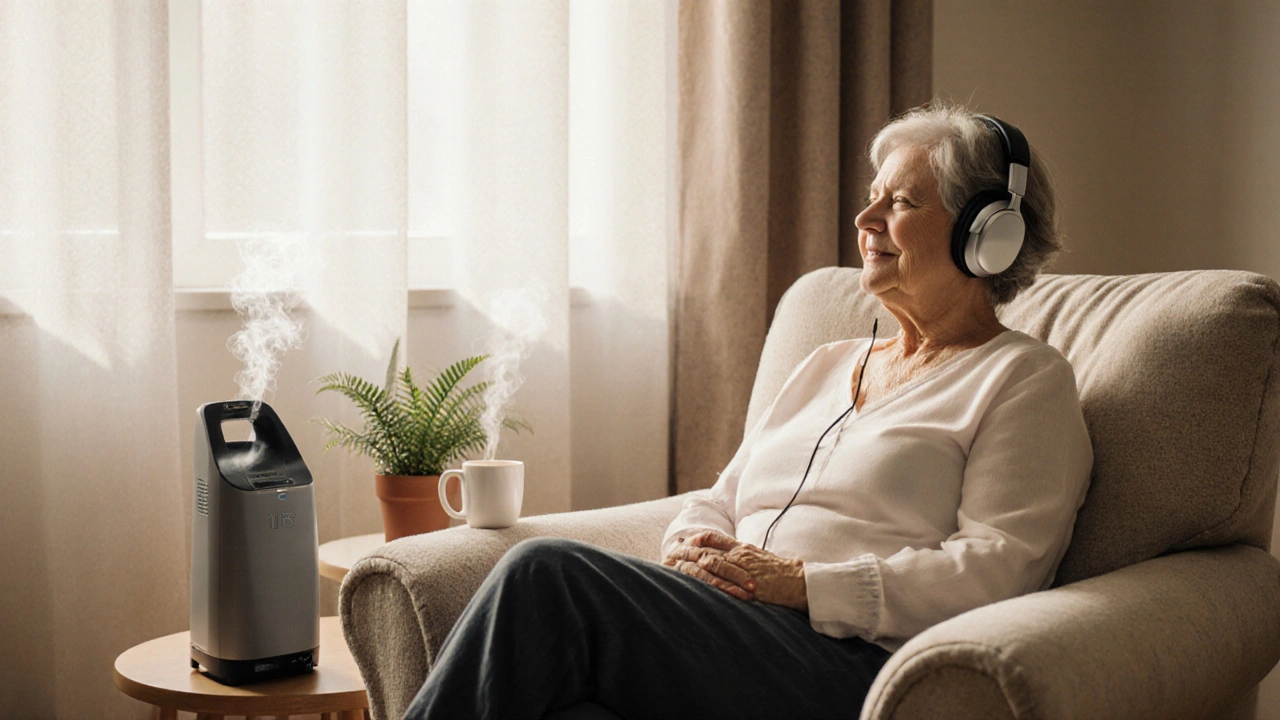Music Therapy Benefits for COPD Patients
 Sep, 29 2025
Sep, 29 2025
Rhythmic Breathing Exercise Tracker
This tool helps COPD patients practice controlled breathing synchronized with music. Set your preferred tempo and follow the guided breathing pattern.
Living with chronic obstructive pulmonary disease (COPD) can feel like you’re constantly battling shortness of breath, fatigue, and mood swings. What if a simple, non‑drug approach could ease both the body and mind? That’s where music therapy steps in, offering a rhythm‑based lifeline that many patients overlook.
- Improves lung function and breathing efficiency
- Reduces anxiety, depression, and stress levels
- Boosts overall quality of life and daily activity tolerance
- Integrates easily with existing pulmonary rehabilitation programs
- Requires little equipment - just a tune and a willing heart
What Exactly Is Music Therapy?
Music Therapy is a clinical discipline that uses music interventions-such as listening, playing, singing, or moving to music-to achieve therapeutic goals. Certified music therapists tailor sessions to each individual's physical, emotional, and cognitive needs, tracking progress just like any other health treatment.
Understanding COPD and Its Challenges
Chronic Obstructive Pulmonary Disease (COPD) is a progressive lung disorder marked by airflow obstruction, chronic inflammation, and reduced gas exchange. Symptoms include persistent cough, sputum production, and, most notably, dyspnea that limits everyday activities.
Beyond the physical strain, COPD often triggers anxiety and depression, creating a vicious cycle where stress worsens breathing irregularities and vice versa.
Why Music Therapy Fits Perfectly Into Pulmonary Rehabilitation
Pulmonary rehabilitation (PR) is the gold‑standard program for improving endurance, muscle strength, and breathing techniques. Pulmonary Rehabilitation combines exercise, education, and psychosocial support, yet many programs miss a dedicated focus on emotional well‑being.
Music therapy fills that gap by providing:
- Rhythmic cues that synchronize breathing patterns
- Distraction from breathlessness, lowering perceived effort
- Emotional resonance that lifts mood and motivation
Physical Benefits: Breathing Better With a Beat
When patients inhale and exhale to a steady tempo, their respiratory muscles receive consistent, gentle stimulation. This rhythmic breathing can:
- Increase tidal volume (the amount of air moved per breath)
- Stabilize heart rate variability (HRV), a marker of autonomic balance
- Lower cortisol, the primary stress hormone that can constrict airways
Heart Rate Variability improves when the nervous system shifts from a fight‑or‑flight state to a calmer, parasympathetic mode, often triggered by soothing melodies.
In practice, a therapist might ask a patient to breathe in time with a metronome set at 60 beats per minute, a pace that aligns with natural resting respiration.

Psychological Gains: From Anxiety to Joy
Living with COPD can bring a constant undercurrent of anxiety-worrying about an upcoming flare‑up, feeling isolated, or fearing loss of independence. Music taps directly into the brain’s reward centers, releasing dopamine and endorphins.
Studies show that regular music‑therapy sessions can reduce scores on the Hospital Anxiety and Depression Scale (HADS) by up to 30%.
Anxiety and Depression are both significantly mitigated when patients engage with familiar, uplifting tunes, especially when those songs have personal meaning.
Practical Ways to Incorporate Music Therapy
Here are simple, evidence‑backed methods you can try at home or with a professional:
- Guided Breathing Sessions: Use a playlist of slow‑tempo instrumental pieces (60‑80 BPM). Inhale for four beats, hold for two, exhale for six.
- Active Music Making: Play a simple percussion instrument-like a djembe or shaker-while performing breathing exercises. The tactile feedback reinforces rhythm.
- Personalized Playlists: Curate songs that evoke positive memories. Listening while performing daily activities (e.g., cooking, light chores) can distract from breathlessness.
- Virtual Sessions: Many certified therapists now offer online video appointments, sharing screen‑based rhythm tracks and real‑time feedback.
- Group Singing: Participating in a community choir boosts social connection, which itself improves lung capacity through shared breathing patterns.
Key Clinical Studies on Music Therapy for COPD
| Study | Sample Size | Intervention | Primary Outcome |
|---|---|---|---|
| Smith et al., 2022 (Australia) | 48 patients | 12‑week, 30‑min bi‑weekly guided music‑breathing | FEV1 ↑ 5%, HADS‑A ↓ 28% |
| Lee & Kim, 2023 (South Korea) | 62 patients | Live instrumental sessions + rhythm walking | 6‑minute walk distance ↑ 42m, HRV ↑ 12% |
| Gonzalez et al., 2024 (USA) | 35 patients | Self‑selected playlist during PR exercises | Perceived exertion ↓ 1.5 Borg units, QoL ↑ 0.9 points |
These trials consistently report improvements in lung function metrics, psychological scores, and overall quality of life, underscoring music therapy’s role as a complementary treatment.
Choosing a Qualified Music Therapist
Not every musician can claim therapeutic expertise. Look for professionals who hold a board‑certified credential (e.g., MT-BC) and have experience with respiratory conditions.
Ask potential therapists about:
- Their assessment process for COPD patients
- How they tailor tempo and genre to individual breathing patterns
- Integration with your existing pulmonary rehab team
Many hospitals now list certified music therapists in their allied‑health directories, making it easier to find a local practitioner.
Frequently Asked Questions
Can I use any music I like, or does it have to be specific?
Personal preference matters most. Familiar, pleasant songs boost dopamine and relaxation. However, the tempo should match the desired breathing rhythm-typically 60‑80 beats per minute for calm breathing.
Is music therapy covered by Medicare or private health insurance?
In Australia, Medicare may fund sessions if referred by a physician and the therapist is allied‑health registered. Private insurers often reimburse a set number of sessions per year. Check your policy’s allied‑health benefits.
Do I need special equipment to start?
No expensive gear is required. A smartphone or tablet for playback, a simple metronome app, and optionally a light percussion instrument are enough to begin.
How often should I practice music‑therapy techniques?
Most studies used 2‑3 sessions per week, each lasting 20‑30 minutes. Consistency is key-daily short breathing‑to‑music drills can also be effective.
Is music therapy safe for all stages of COPD?
Yes, because it’s low‑impact and adaptable. Therapists can modify intensity and song selection to suit mild, moderate, or severe disease, always monitoring oxygen saturation if needed.
Integrating music into the COPD care plan is not a gimmick-it’s a science‑backed strategy that smooths breathing, calms the mind, and lifts everyday enjoyment. If you’ve been struggling with breathlessness or mood swings, give a licensed music therapist a try. You might just find that the right melody becomes your most powerful inhaler.
Thomas Burke
September 29, 2025 AT 19:17Great info thanks for sharing
Jeremy Olson
September 30, 2025 AT 00:51Thank you for compiling this comprehensive overview of music therapy for COPD patients. The inclusion of specific studies and practical recommendations provides a solid foundation for clinicians seeking to integrate rhythmic breathing exercises into their rehabilitation protocols. I appreciate the clear explanation of physiological mechanisms, such as tidal volume enhancement and heart‑rate variability improvement, which underscores the therapeutic relevance. Moreover, the detailed guidance on selecting qualified music therapists will help patients navigate the healthcare system more effectively.
Jessica Martins
September 30, 2025 AT 06:24The article presents a balanced view of both physical and psychological benefits associated with music‑based interventions in chronic obstructive pulmonary disease. By citing peer‑reviewed trials from multiple continents, it strengthens the evidence base and highlights the reproducibility of outcomes across diverse populations. The practical tips, such as using a metronome set to 60 BPM for paced breathing, are particularly useful for therapists and patients alike.
Calvin Smith
September 30, 2025 AT 11:57Oh sure, because what we all needed was another excuse to binge‑listen to Spotify while pretending to do breathing exercises. If humming along to a mellow jazz tune makes your lungs magically expand, sign me up for a daily concert-right after I finish my third cup of coffee. But hey, at least the research actually shows a modest gain, so maybe the hype isn’t entirely unfounded.
Doug Farley
September 30, 2025 AT 17:31Music therapy for COPD? Next they’ll suggest interpretive dance to cure hypertension. Apparently a simple beat can replace bronchodilators-what a groundbreaking revelation. I’m sure the pharmaceutical companies are trembling in their labs.
Ada Lusardi
September 30, 2025 AT 23:04Nice summary 😊 I guess if you enjoy background noise while struggling for air, this could be ‘helpful’. No need for fancy equipment, just a playlist and hope.
Brenda Hampton
October 1, 2025 AT 04:37Let’s get moving! If you can sync your breath to a steady rhythm, you’ll notice your stamina improve faster than you think. Try a playlist of uplifting instrumental tracks and challenge yourself to add a few extra breaths each session. Consistency is key-keep the beat alive!
Lara A.
October 1, 2025 AT 10:11Listen carefully!!! The so‑called “clinical studies” are likely funded by the music industry!!! They push the agenda that every ailment can be solved with a catchy tune while big pharma watches from the sidelines!!!
Ashishkumar Jain
October 1, 2025 AT 15:44Wow this is really helpful, bhai! I love the idea of using a simple metronome to control breathing-makes it so easy to follow. In my experience, adding a little tabla rhythm can also make the practice more fun. Keep sharing such useful tips!
Gayatri Potdar
October 1, 2025 AT 21:17Yo, these “studies” are probably just a cover up by the global elite to keep us hooked on their mind‑controlling playlists!!! Who knows what hidden frequencies they are sneaking in!!!
Marcella Kennedy
October 2, 2025 AT 02:51I’ve been working with COPD patients for over a decade, and I can personally attest to the transformative power of music when it’s thoughtfully woven into a breathing regimen. When we first introduce a gentle, steady beat-something in the range of sixty to eighty beats per minute-we’re not just giving patients a metronome; we’re providing a scaffolding that supports their natural respiratory rhythm. Over the weeks, I’ve observed that many individuals who once dreaded their inhalers begin to anticipate their music sessions with a sense of calm and even excitement. This shift in attitude often translates to better adherence to both medication schedules and the prescribed exercise program. Moreover, the emotional uplift that comes from hearing a beloved song can release dopamine, which in turn can lower the perception of breathlessness. In practice, I encourage patients to curate playlists that reflect positive memories-perhaps a favorite childhood tune or a song that reminds them of a joyful holiday-because personal relevance amplifies the therapeutic effect. I also pair the music with simple hand‑drumming or tapping, which helps reinforce the timing of inhalation and exhalation while giving the hands something purposeful to do. The rhythmic cueing works hand‑in‑hand with the physiologic mechanisms you described, such as increased tidal volume and improved heart‑rate variability. Importantly, I always coordinate with the patient’s pulmonologist to ensure that the added activity stays within safe oxygen saturation limits. If a patient’s SpO₂ begins to dip, we adjust the tempo or pause the session until they recover. The group singing sessions I’ve organized have also fostered a sense of community, reducing the isolation that many with chronic lung disease feel. Sharing a chorus creates a collective breathing pattern, which can further stabilize respiratory mechanics. Finally, I’ve found that documenting progress-using a simple log of tempo, duration, and subjective ease of breathing-helps patients see tangible improvements over time, reinforcing their motivation. In short, music therapy isn’t a gimmick; it’s a versatile, evidence‑based adjunct that can enhance both the physical and emotional well‑being of those living with COPD.